
THE TOWN OF SHOVEL LAKE, MINNESOTA

Introduction
Photographs
Interview With Clyde Saylor
Excerpt From "Beyond The Circle"
Historical Vignet from the Aitkin Age Newspaper

Shovel Lake existed from 1910 until 1952 as a Soo Line Railroad Station and a US
Post Office. There was a school and a bank for awhile. The general store, which also
served as the post office, was operated by William (Bill) and Ethel Russell. My mother
lived with the Russells for a while after she left the farm, and I have memories of visiting
them at their general store.
I hope to spark interest in the history of the town. I have been doing extensive
research into my grandparent's history, Croatia to New Mexico to Minnesota. I feel that
time is running out because people who remember places like Shovel Lake are well up in
their 80's now.
Thank you for what you do.
(And thank you, Jim Malecki !)

THE TOWN OF SHOVEL LAKE, MINNESOTA

Introduction
Photographs
Interview With Clyde Saylor
Excerpt From "Beyond The Circle"
Historical Vignet from the Aitkin Age Newspaper



SHOVEL LAKE IN 1915
The house in the center is still there today.
Contributed by Randy Wall
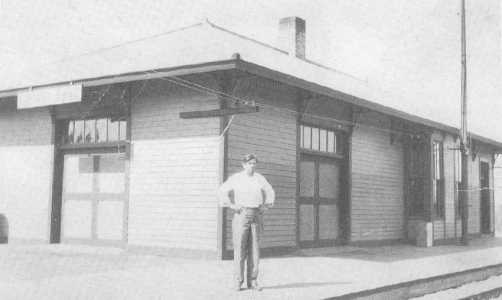
SHOVEL LAKE DEPOT
This was taken by Newlon Harrington in 1912 when he was a pioneer photographer in the area.
Contributed by Stacy Vellas

INTERVIEW WITH CLYDE
SAYLOR
by Stacy Vellas
August 31, 1995, Hill City, Minnesota
My Dad, Ignatius Saylor, was from Zanesville, Ohio. When he was twelve years old his family moved to Mason City, Iowa. He lived in Mason City until he was twenty-one. He and his brother Frank Saylor decided to leave Mason City in 1896. They decided to look for homestead property in Aitkin County. Between Mason City Iowa and Hill City Minnesota all the good farmland had been homesteaded before 1900. When they arrived in Northern Minnesota he decided to take out a homestead in the Shovel Lake area. There was no town there at the time. It was just wilderness. The homestead he chose was in the far northwest corner of Aitkin County.
Ig's brother, Frank Saylor took out a homestead in Cass County east of Remer. Dad's land was right on the lake that they named Saylor Lake.
Ignatius Saylor proved up the homestead in Shovel Lake but he lived in Hill city until 1912. That was the year the Soo Line went through the Shovel Lake Area. While he lived in Hill City he built a house for the family one block down on the left from the Hill Lake Manor where I live. The house is still there. In 1912, the family moved out to the homestead north of Shovel Lake.
When Ig Saylor first arrived in Hill City he worked with a surveyor, running township lines. He was running lines for the surveyor north of Hill City near the southern edge of Itasca County. One day they stopped at noon by a little lake and the surveyor said, "We have to put a name on this lake and get it on the map. What shall we name it?"
My dad said, "As long as we eat dinner here every day, let's name it Dinner Lake."
Somebody added the "Pail" to it afterwards, I don't know who did that. From then on it went by the name, Dinner Pail Lake.
Dad stayed with that surveyor for a while and helped him out. Another interesting incident happened north of Shovel Lake where a Catholic priest owned forty acres. The priest wanted the lines run on his land. When the surveyor and my dad ran the lines on it they found most of his land was in the lake. They had to name it, so dad said, "Let's call it Holy Water." That is where it got its name and is still called Holy Water Lake today.
My dad was a very good carpenter, very finicky. He was also a really good violinist. He used to play a lot of "them old hornpipes," as they called them: "Fisher's Horn Pipe," "Boomerang's Horn Pipe," and fast tunes like "Devil's Dream." He also played a lot of Waltzes like "Over the Waves."
We lived out on the farm when I was a child. We raised mostly potatoes and we ate potatoes all winter. Whatever was left in the spring we fed to the hogs. We were too far from the market to sell the potatoes. In 1917, during the World War I, Dad had every piece of ground he could grow plants on planted in potatoes and that year they made money on potatoes. That was the only time they made any money on potatoes. We had a lot of dairy cattle. We had venison and pork for meat. There is only one time in my life I remember eating beef. Venison was the staple food. Sonny Pierson's daughter said she was twenty-seven years old before she knew there was any other meat besides venison.
In 1923, I started school at Shovel Lake School when I was six years old. The first school was just a wood frame building. They built the big brick school in 1925. I went there from first to eighth grade. I remember one year they had a high school teacher in Shovel Lake. She was called Sister Dorothy. She was probably the teacher for the first freshman class held at Shovel Lake High School. The school was in a building that used to be the old liquor store many years before.
Most of my time I spent at home on the farm except for school. We hardly ever went to town. I played anti-I-over with my brothers. We played horseshoes a lot. I didn't hunt when I was young. In 1940, I shot my first deer. We wore mostly overalls and my mother made our shirts with her old sewing machine.
In the 1920's there were fires all around our homestead and the family decided it was not safe on the farm so we all went in to Shovel Lake. The four youngest children of the family stayed over night at the hotel. The rest of the family returned to the farm and with sprayers kept the buildings wet down. The fire finally burned itself out. After the fire we had a bumper crop of raspberries. That's about all we got out of it. My mother never stopped canning until she had a hundred quarts. It was the same way with blueberries.
My mother was very strict. She used to call one of us kids and she'd name everyone in the family. She had eight kids, Glenn, Joe, Floyd, Dorothy, Ray, Faye, Clyde and Ethel. Floyd was the one that was the hardest to handle. He would forget to come home from school. He spent a lot of time in the logging camps instead of doing his homework. The teacher jousted him up good. The teacher could hit you back then. Some of the teachers were actually mean.
One of them was Ethel O'Linn. Oh, she was wicked. I talked to Ethel O'Linn after I came out of the army. I met her at the station down at the junction. She said, "You know, that brother Joel, was the meanest kid that I ever taught in my life. Your dad told me not to spare the whip and believe me I didn't." She stopped teaching years before I started school.
CLYDE SAYLOR'S PHOTOS
This picture (showing me his photos) is of dad's next to the youngest brother, Joe Saylor. He was the first mayor of Hill City.
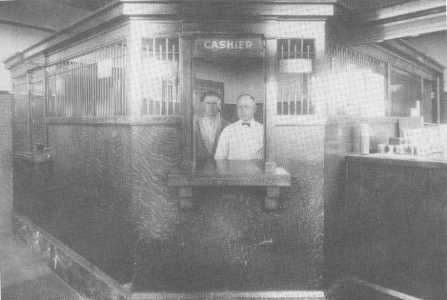
This man was the head of the bank. He was Gotfred Nicholson. I don't know where he came from.
This is my brother-in-law, George Kelly. He was married to my oldest sister, Dorothy. He was cashier at the bank and the man the Kelly School was named for.
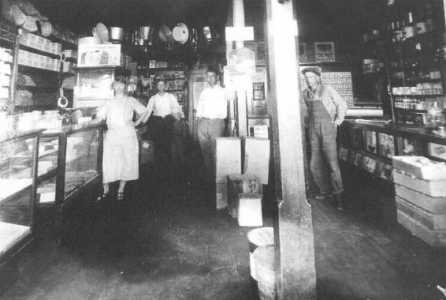
This picture was taken in 1923. This was the first store in Shovel Lake. Roscoe Reynolds had this building built and he ran the store for many years. I don't know how many years he had it.
Fred Blais (pronounced Blair) came into the country to log in the Shovel Lake area. He had the big log mill west of Shovel Lake about half a mile from town on the Willow River. He taught Bill Russell to be the timekeeper for the Blair Logging operation.
This is Ethel Russell.
This fellow is the Soo Line Depot agent, Henry Daskoski, in Shovel Lake.
This little fellow standing next to him was Bill Russell's boy.
This fellow I haven't identified.
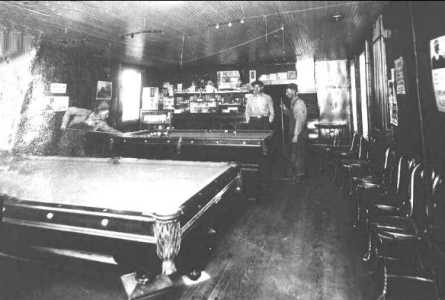
This is the old pool hall in Shovel Lake and I don't know who these people are. These pool tables are the old Brunswick tables probably the best ever made. There are spittoons in the picture as most of the men chewed tobacco back then or smoked cigars.
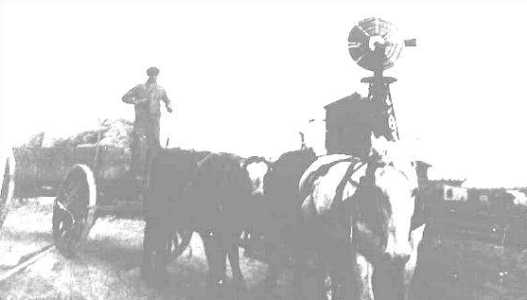
This is my brother Glenn Saylor, in 1917, with a team of oxen and a white horse in the lead hauling potatoes into Shovel Lake. There was a warehouse in town and they had a grader and graded them according to size and shipped them by rail from there. This is a sidetrack on the railroad and that is the main tracks. There was a water tank for the trains.
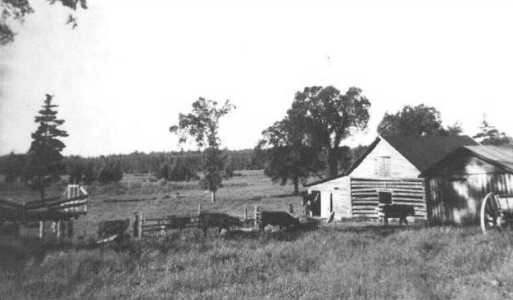
This is our old homestead. That picture must have been taken the summer of 1942, the year I went into the army.
This is my dad, Ignatius.
This is his brother, Frank who came with him.
This is the picture of the town. This would make a nice painting.
That was my Uncle Frank Saylor's homesteaded house up on Saylor Lake. Norah Harkins was my dad's mother.
That was my dad's Uncle, David Harkins. He died in Andersonville Prison during the Civil War. (1865)
There were two brothers, David and Joel. I think this one is Joel.
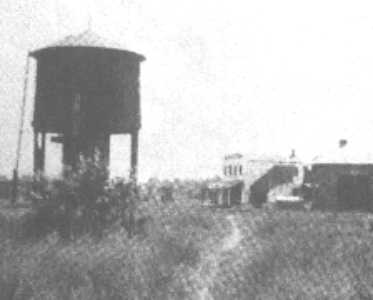
This is the town of Shovel Lake.
That is Russell's store. This was taken before Roscoe was there at the time the Soo Line went through Shovel Lake in 1912. It went through Swatara in 1910.
This is the caretaker Roger Batdorf and my boys, Albert and Billy.
Bill Russell came to Shovel Lake from Cedar Rapids, Iowa. He was a timekeeper for Fred Blais (Blair) and Blais talked him into buying the store and putting in a line of hardware due to the fact that Fred had the lath mill operation and they needed a lot of supplies. Russell started out in 1917 and he ran the store until 1948. The store was right across the street from the hotel. All that is left in Shovel Lake is Bill Russell's Store.
Ignatius Saylor stayed on his homestead until I (Clyde) went in the army in 1942. Then my dad had an auction. He sold the place, the horses, the rest of the cattle, retired from farming and moved into the town of Shovel Lake. He and my mother lived there until my dad died in March 1949. The first summer after he retired he worked in the shipyards in the state of Washington. The next year he went to Michigan and worked for Continental Motors. Then he quit working.
My mother, Nora A. Carpenter Saylor was from Nebraska. When they retired she went to work in Duluth. She was president of one of the banks and owned a big house on Graceland (?) Boulevard. She stayed there until 1952. She died in her sleep on November 28, 1952. She was sixty-four years old. My dad must have been seventy-five or six. Right now I'm older than he was.
I got married in San Diego to a woman from Hill City. Leona M. Valley is my wife's name. Her ancestors came from Canada. They were French Canadians. I went into the service and she went to work in San Diego at Consolidated Aircraft. Before that I worked for Continental Aircraft in San Diego until Pearl Harbor. I came home to Shovel Lake for Christmas and then I went back and enlisted.
After I got out of the Army I came back to Hill City. Chet Sailor (no relation) had the bar and pool hall in town. I got out on July 3rd and I went to work for the County. My brother was County Road foreman so I went to work for them that fall and worked until the next spring. Then I went to work in Grand Rapids for a man named Chalburt building houses for a year.
Then, my brother-in-law, George Kelly said, "Why don't you go to work on the Iron Range. They are hiring up there." So, I went to Coleraine and went to work at first on the Tri-team on the railroad. Then I jumped around from one job to another. I worked on steam locomotives for a while. Then I worked on drills at Diamond Ford Drilling doing exploration drilling for iron ore. I also worked in the washing plants. The last year I worked in the research laboratory in Coleraine. I had worked there for three or four years. Then they contracted the work out that I had been doing. I went back and worked in the washing plant. When that plant closed down I went to work for U.S. Steel and retired from there after thirty-two and a half years.
Stacy, I remember your dad. He was called Jimmy the Greek. He wore high-buttoned shoes back in about 1928. It was when he was living in Hibbing. He happened to come to our farm one day after chore time in the summer. We had just lost our big brood sow. My dad didn't know what to do with her. It was hot and we had no refrigeration. Your dad said, "I take her an' I get rid of her." We gutted her and bled her the best we could. He took the pig to Hibbing and sold it.

"SHOVEL LAKE AND PINE TREE SPUR"
Excerpt from "Beyond the Circle"
by Leo Trunt
Published with Permission of the Author
Transcribed by Karen Klennert
For Purchasing Information, Contact Leo Trunt

When the author first heard of Shovel Lake, the thought crossed his mind, "Where was that town located?" He became intrigued about that area and looked into it in more detail.
Tom Skinaway called Shovel Lake, "Quah-ba-a-wan-gwan-ne-se-ka-a-gani." (A Century of Pioneering Pioneers, page 21) Tom and his family used to harvest wild rice at Shovel Lake, and they had a camp on the lake during their harvest. They used to sell the rice to the Russell Family who in turn would sell it for 10 cents a pound. (Ibid, page 21)
The Native Americans no doubt had been harvesting rice and utilizing the area for many centuries. Wild game was plentiful and the Willow River provided a good means of transportation.
The early loggers also found that the Willow was an excellent river to raft logs on. A dam was constructed on the mouth of Shovel Lake and water was held back. The Willow River used to flow in and then out of the lake, and it was backed up into the lake which raised the water level several feet. Logs made their way into the lake and then the dam was opened and the logs sluiced nicely down the Willow. Some of the first settlers worked on the log drives or in the logging camps.. The logging first started in the 1880's, and the log drives continued until about 1911. After that, the drives ended and settlers moved in rapidly.
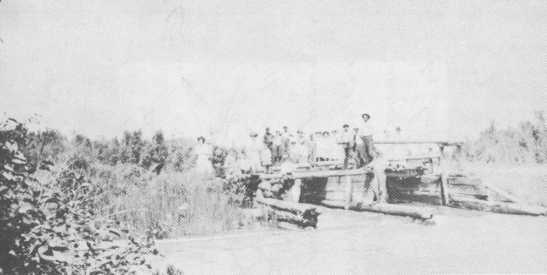
The Shovel Lake Dam, 1913
Courtesy of Herman Nelson via Karen Bailey
The first settlers in the area were the Ralph McNeil, J. R. Gillson, Bill Russell, Roscoe Reynolds, Fred Blais, Batdorf, Baudy, Shellhardt, and O'Brien families. They started coming about 1903, and soon were carving farms out of the wilderness.
Ralph McNeil was a game hunter when he first came to town. He hunted in the area for the various logging companies to feed their men. He also worked on the river drives as they went on down to Aitkin. (Per interview with Ralph (Doug) McNeil on July 2, 1996)

Blais Letterhead
Courtesy of Aitkin County Land Department
Fred Blais had been in the area for a number of years and had been in the lumbering business around Aitkin for some time. He logged along the Willow River and for a time, had his base of operations in Remer. He drove logs down the Willow as late as 1911 which was even after the river had been dredged. "Fred Blais has started his log drive of two million feet from Thunder Lake in Cass County, via Willow and Moose Rivers to the Mississippi. Two large bends are cut off by using State Ditch No. 93 and 86 respectively, which it is claimed will be of benefit to the ditches by cleaning them out." (Aitkin Independent Age--May 20, 1911) He saw a real opportunity when the Soo Line came to town. Fred had a number of timber holdings in the area, and so in 1910, he and a couple of partners set up a lath mill just west of town. It was located at what was called "Spur 308." Here the mill was set up and built on the riverbank of the Willow River. A spur was run to the mill for loading the lath on rail cars. Some wood was floated along a channel of the Willow that was dredged out and used as a sort of "boom pond." These were then brought up to the mill up a sluice ramp. "The Shovel Lake Lumber Company has just been incorporated with Fred Blais, president; Thos. St. Peter, vice president; and Irvine Innes, secretary and treasurer. The authorized capital is $50,000.00 and the articles provide for doing a logging and sawmill business and dealing in general merchandise. They have selected a site for their mill in close proximity to Shovel Lake and the Willow River and have shipped the machinery to that place. A spur track from the Soo road is to be run into the mill yard. Camps for the men are being put in readiness for the coming season's operations. The office and store of the company will be at Shovel Lake Station, a short distance away from the mill." (Aitkin Republican--November 5, 1910)

Fred Blais Lath Mill at Shovel Lake
Courtesy of Lucy Blais
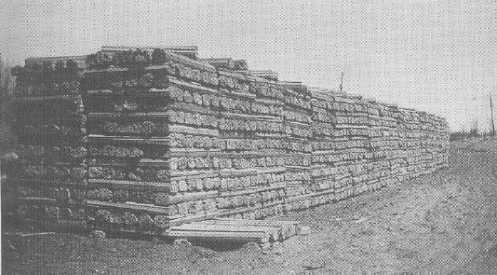
The Finished Product of the Fred Blais Lath Mill
Courtesy of Lucy Blais
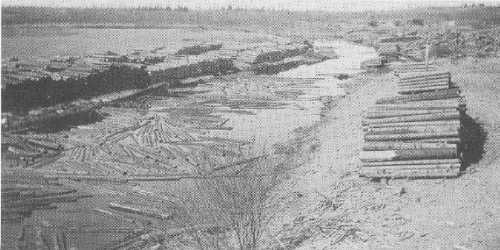
Mill Pond of the Fred Blais Lath Mill
Courtesy of John Russell
Transportation was difficult for the early farmers as there were no roads to any extent. There was an old tote road that worked its way south to Aitkin, but it took several days to get there. One of the early farms to the south of town was known as the "Polly Ranch." (Interview with Ken McNeil on May 9, 1996)
Things started to hum when the Soo Line Railroad came to town in 1910. The grade was pushed through town and west to Remer and beyond. With the coming of the railroad, a station was established at Shovel Lake. A 24' by 28' Section house was built in October of 1910. In December of that year, a water tank was installed along with a windmill and well. In February of 1911, a pump house was installed. In March of 1911 an 8' by 126' passenger platform was built. A depot with more platform area was constructed in November of 1912. By December, a train order signal was placed along with an outhouse. A Dago car was put in place in 1916. In November 1919, the stockyard was put in with a shed, feed rack, and well. A new well was drilled in 1924 (in the bottom of the first dug well) for the water tank. Then a mail crane was put in place in 1934. Another loading platform was built in October of 1946. (Soo Line Historical and Technical Society Records.) Mr. Deskaski was one of the depot agents with Matt Simonson as the section foreman. (Per interview with Kit and Evelyn Butterfield on November 2, 1995).

Shovel Lake Depot 1914 ~ B. E. Gaddy, Agent for Soo Line
Courtesy of Lin Russell
Roscoe Reynolds was the first postmaster for Shovel Lake, being appointed on October 27, 1910. (U. S. Postal Records) Reynolds also built a store in town soon after the railroad came. He ran the store until 1916, when he sold out to Bill Russell. The Russells ran the store until 1958 when they closed it for good.
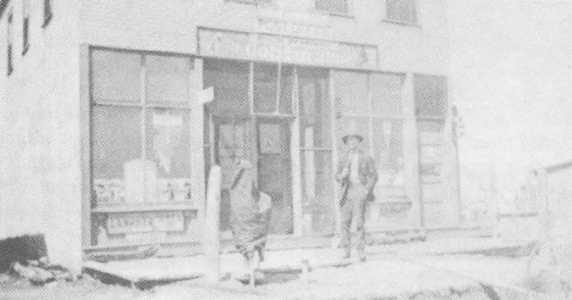
Shovel Lake Post Office & General Store of Roscoe Reynolds
Courtesy of Herman Nelson via Karen Bailey
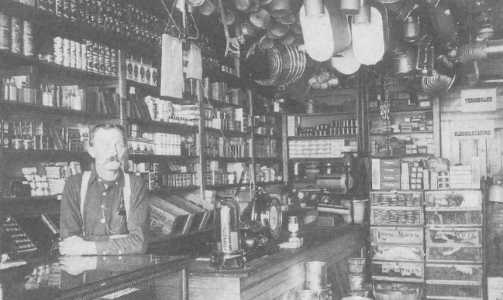
Roscoe Reynolds' Shovel Lake Store 1912 ~ N. P. Nelson, Store Cler,
Courtesy of Lin Russell
Roscoe had the first car in town which was a big Studebaker. The car was brought up by driving the roads to Swatara, but due to the lack of roads, it had to be loaded onto a railroad flatcar to be brought to Shovel Lake. He had to drive in and out around all the stumps that were still in the streets of town. If he wanted to go to Aitkin he had to load the car onto another flatcar to get to Swatara and then drive it down the roads from there. (A Century of Pioneering Pioneers, page 28)
There was another store in town as well. It was built by D. B. Heath, who ran it for a short time. He sold out to a Mr. Durman, who consequently sold out to Elmer R. Sherman. Manson Caverly had a car repair garage and blacksmith shop. John Otto also had the blacksmith shop. There was another good blacksmith in the country southeast of Shovel Lake. This was Ernest Klennert. "Ernest was a blacksmith in his own right. He was a big, big man. He used to do work for the surrounding farmers." (Per interview with Russell O'Brien on September 7, 1995)
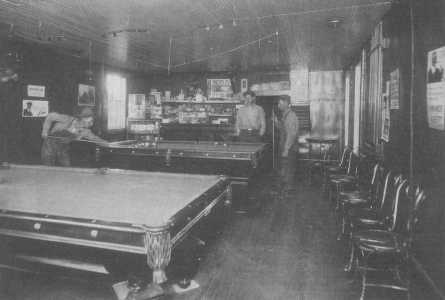
Shovel Lake Pool Hall, 1923
Courtesy of Clyde Saylor
Mr. Sharabonda ran a restaurant and also a pool hall and barber shop. Actually, the businesses exchanged hands a number of times. "The pool hall was closed Wednesday of last week, Paul Kluber, operator, selling out his stock of supplies to W. B. Russell." (Aitkin Republican--June 18, 1925) For a time the pool hall and barber shop were run by George DeRosier. (Per interview with John Russell on January 13, 1996)The Remer Lumber Company ran a lumber yard in town for a few years. ( Remer Record--January, 1926)"....This is operated by Mr. Nicklason, cashier of the bank, who looks after the yard as a sideline, and a good service is performed for the community by this institution." (Hill City News--November 26, 1925) There was a livery business, a potato warehouse, and a bank. A peat factory building was also constructed.

Shovel Lake Cedar Yard
Picture was taken on top of the windmill.
The circular roof is the top of the water tank.
The Soo Line Depot is on the right.
Courtesy of Lin Russell

Main Street of Shovel Lake
Russell & Sherman Stores on left, Rackliff Hotel on right.
Courtesy of Lucy Blais
Eugene Rackliff had a logging operation in the area and his wife May did the cooking and ran the hotel in town. The hotel was run like a boarding house, as there was a need for such with all the men working in the area. Gene managed to get a liquor license and ran a saloon for a few years.
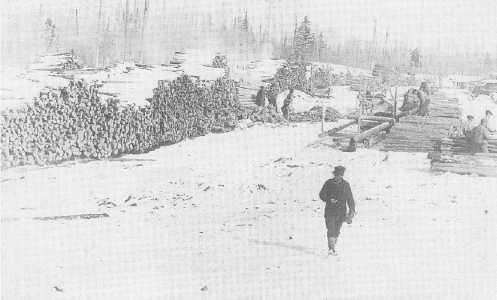
The Holy Water Lake Camp of Fred Blais, 1920
Courtesy of Lucy Blais
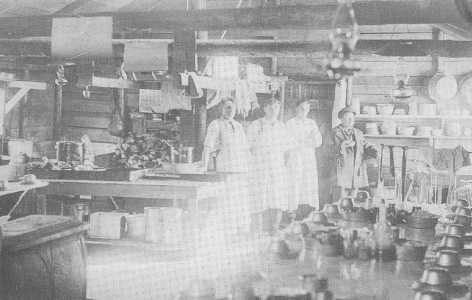
Inside the Fred Blais Camp Kitchen and Dining Hall
Courtesy of Lucy Blais
A large camp was set up in the Holy Water Lake area. Fred Blais had upwards of 600 men working for him. "Mr. Blais has been for several years one of the largest operators in woods products in this region. Last winter he employed six hundred men, and a great deal of material in the shape of ties, posts, poles, etc., was got out." ((Aitkin Age--February 23, 1922) Here large stands of timber were cut and hauled to the Blais mill. The log drays were pulled to the mill with the use of "Holt" caterpillars or skidders. They ran continuously during the winter months. An ice road was constructed up to the Holy Water Camp with the use of water tank sleds. The mill had a generating plant and had numerous lights even on the outside. (A Century of Pioneering Pioneers, page 30) The mill ran quite well until about 1925. During the peak of operations he would ship an entire train load of timber products daily during the entire winter season. (Fred Blais obituary dated February 1956) After that it ran sporadically and finally shut down about 1928. (Remer Record--November 12, 1930) Blais also had a large operation southeast of Jacobson from 1926-28. (Hill City News--January 28, 1926)
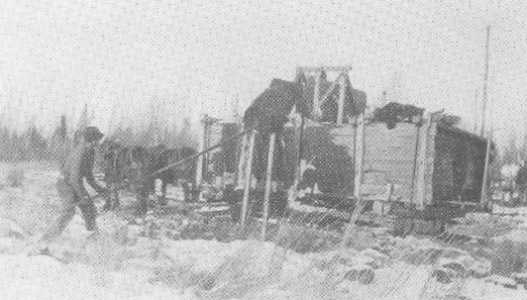
Filling the Water Drey to Make the Ice Roads at Holy Water Lake, 1920
Courtesy of Lucy Blais
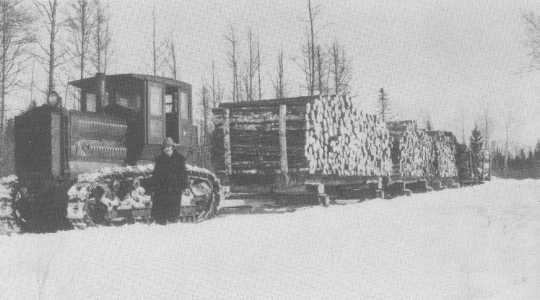
Fred Blais' Skidder Hauling Logs on the Holy Water Lake Ice Road, 1920
Courtesy of Lucy Blais
To the west of Shovel Lake, just over the Cass County line, was a place known as the "Pine Tree Spur" or Spur 310. The spur had a rough platform constructed and was used as a loading dock for the Weyerhauser timber interests. The company was called the Pine Tree Lumber Company, hence the name of the spur. Supplies and material were dropped off here for the lumber company. A railroad spur went northeast from the spur and ran up and through the northeast corner of Cass County and on into the southwestern part of Itasca County. This was known as the "Shingle Mill" area, and the spur ran through a portion of that country. There were camps at the end of the spur where men were working to bring the timber to the grade. "Logging operations in the vicinity of Shovel Lake are booming this season. The Weyerhauser people are getting out enough to keep a train employed on their spur above that point and E. P. Rackliff is loading seven cars a day at Shovel Lake, which with the Weyerhauser camps load a train a day, generally about 40 cars." (Aitkin Republican--January 28, 1911)
Not much is known about the shingle mill, the spur or the camps of this area. There are only a few scattered accounts of this territory and for some reason it was not documented in any substantial way.
There was a pretty good uphill grade coming from Shovel Lake and so the railroad didn't like to stop there if they had a big load on, as it would be difficult to get going again. This became the crux of a problem for the railroad in 1917, when the Soo Line became involved with a lawsuit with Thomas Leonczak. Leonczak had a farm near Pine Tree Spur. One evening he was riding the train, which was heavily loaded down. The train crew did not want to stop at Pine Tree Spur as they might not be able to get started again with such a load and the steep grade. When they got to Pine Tree Spur Station, they tossed off Leonczak's luggage and physically threw him off the train near the makeshift unloading platform. He went for a tumble and was hurt badly, or so he claimed. Leonczak sued the railroad, and the case went all the way to the state supreme court. Leonczak was awarded $15,000.00 in the lower court case held in Walker, MN. (Minnesota Supreme Court Case #24117, Mn. Hist. Society file # 11.9.G.20.6.F) The upper court upheld the lower counts determination and Leonczak prevailed. However, after his attorney's fees and other costs, he probably didn't realize much for compensation.
In 1912, the first school in Shovel Lake was built by Ed Rassier for $1,098.00. (Hill City News--August 15, 1912) It was a one room frame building. This school was sufficient until 1925 when the new brick school was built by Louis Johnson of Aitkin. (Remer Record--July 4, 1925) This was a fine building with two classrooms, an auditorium with a stage, a kitchen and even a fireplace. This building, which was built for about $10,800.00, (A Century of Pioneering Pioneers, page 29) was also used for community gatherings. The school district was known as District Number 116. Hosea Gritten was an early school bus driver and also a janitor for the school. (Per interview with Kit and Evelyn Butterfield on November 2, 1995) There was a school to the south of Shovel Lake that was known as the "North Lemay" or the "Green School." It ran until the new brick school was constructed in Shovel Lake and then the children were transported in.
Shovel Lake was platted on August 15, 1910 by the Tri State Land Company. (Per Plat of Shovel Lake--Aitkin Co. Recorder's Office) An addition to the town was created when blocks 5-8 were added by the Tri-State Land Company on December 24, 1917. (Per Plat of Shovel Lake--Aitkin Co. Recorder's Office)
Another land speculation concern was the Shovel Lake Land and Colonization Company. This firm bought and sold farm lands in the area and was incorporated by S. H. Eckman, H. G. Hearhart, W. B. Russell. E. E. Sutton, Charles Magnuson, James Murray and August Polson.(Per Articles of incorporation of the Shovel Lake Land and Colonization Company--Aitkin Co. Recorder's Office)
The people felt the need to improve their roads and take care of other local needs, and so Shovel Lake Township was organized on July 17, 1912. A telephone system was set up, and a small central was operated in town. The line was eventually merged with the Remer phone system. The township also established a cemetery. Sam Bailey was the assessor, and Florence Butler was the clerk for the township in 1940, just a few years before the township dissolved. (Per Shovel Lake Township Records, Aitkin Co. Land Dept.)The township remained organized until May 4, 1943. (Aitkin County Recorder's Office) After that, the cemetery was taken care of by the local people in a cooperative effort.
Bill and Ethel Russell arrived in town in 1914. "Bill had told her she would be the only 'white' woman in town, and she was nervous about so many young lumberjacks and natives. When the train stopped in Shovel Lake there was Mrs. Rackliff from the hotel and Mrs. Olson and a small group of other towns women standing by the depot to greet her. She had never seen a more welcome sight than those women's faces. Ethel got busy and organized the first Ladies Aid Society and had parties. She soon also had part proprietorship of the Red and White General Mercantile store." (Letter written by Lin Russell dated February 10,1996) The store held the basic needs of flour, sugar, lard and bolts of summer calico and winter heavy wool cloth. Here you could get a steel button or a pair of children's shoes. The U. S. Post Office was also in the store, and one of Bill and Ethel's daily duties was to meet the train with the mail pouch ready. The store was the Sears and Roebuck. It was the gas station and the gathering spot for men with snuff and ladies with new babies. Ethel even hosted Easter Sunday services in their home upstairs and "laid out" several townsfolk who didn't survive illnesses. Ethel was quite a hunter as well. She was known to be quite successful in her outdoor abilities in trapping, hunting and fishing. Herman Nelson in his book, "A Century of Pioneering Pioneers," referred to her as the "Huntress of Shovel Lake."
The ladies group became an active social entity. "The sewing project ladies held their home achievement day last Saturday evening in the community room. A very entertaining program was given consisting of songs and drills by the small children under the supervision of Miss Minnie Dunne, a Bug-a-boo drill by some of the larger boys and a costume pantomime by the ladies. Each picture was accompanied by an appropriate song by the choir consisting of Jack Cunningham, George Kelly, Frank Kluber and F. E. McLaughlin with Miss Neva Hake as pianist. Solos were also sung by Mrs. Russell, Miss Dunne and Erma Hake. Six booths were attractively arranged and decorated by committees. One each on textiles, finishes in silk and wool, attractive house dresses, demonstration of cutting and fitting, remodeled clothing, and children's garments. Pie and coffee was served to a very large attendance." (Remer Record--November 7, 1925)
D. A. Robinson, R. W. Wedgewood and E. Vallet set up the Shovel Lake Land Company. "The company expects to saw out a large footage of fine furniture lumber this winter, besides other salable house building boards. They have a fine planning mill and are preparing to make all kinds of finishing lumber." (Aitkin Republican--November 11, 1914)
In the years preceding the prohibition, there were areas of the state that were being closed to alcohol. This was due to the 1855 treaty that was being interpreted on a case by case basis, and one by one, towns were closed to the serving of alcohol. Hill City had been closed first and then Shovel Lake's turn came. "Saturday was a great day for Shovel Lake and Aitkin County. The saloon at that place and the only one in the county closed its doors. Aitkin County can again hold up its head and be proud of the fact that the brewery trust does not control it. It is reported that the Shovel Lake saloon went out in a blaze of glory, the booze remaining unsold at closing time being given away. It is also rumored that quite a quantity of this liquor came to Hill City. (Hill City News--February 4, 1915)
Prospects looked promising in the early years and so on August 17, 1916, the Shovel Lake State Bank was formed. The incorporators were: James K. Murray, Chas Magnuson, Fred Blais, E. E. Sutton, and Gust Hostrom. The bank started out with a capital stock of $10,000.00. (Cert. of Incorporation of Shovel Lake State Bank, Aitkin Co. Recorder's Office) Harold Houdek was the first cashier with Gotfred Nicklason becoming the second cashier. "The bank always the backbone as well as the core of the community, is a well managed institution with Godfred Nicklason as cashier, and George Kelly as assistant cashier. The last statement of the bank shows total assets of more than $85,000.00 with deposits of almost $62,000.00. The statement shows W. B. Russell, Shovel Lake merchant, as president of the bank, and E. E. Sutton and Chas M. Magnuson as two of the directors. The bank is a progressive institution housed in a neat and well built stucco bank building." (Hill City News--November 26, 1925) Gotfred had bought two shares in the bank worth $200.00 in 1923, and then sold those shares in 1925. He then bought 37 shares in 1919 worth only $3,700.00. (List of Stockholders--Shovel Lake State Bank, Aitkin County Recorder's Office) Gotfred also served as the treasurer for Shovel Lake Township. (Aitkin Republican April 3, 1924)

Shovel Lake State Bank, 1923, George R. Kelley and G. Nicklason
Courtesy of Clyde Saylor
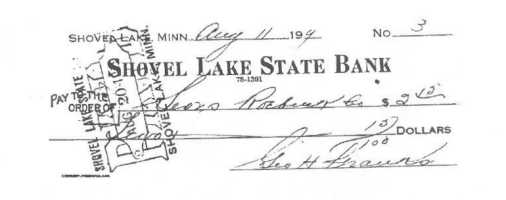
Canceled Check of the Shovel Lake State Bank
Courtesy of Aitkin County Land Department
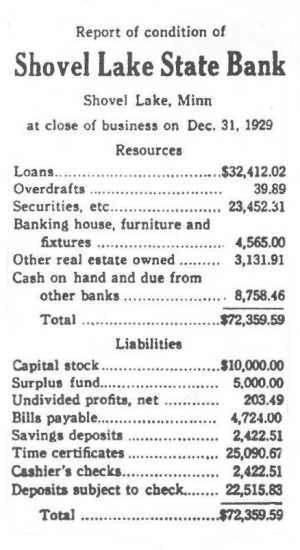
Bank Report
Courtesy of Hill City News
Shovel Lake had a baseball team, as did many towns. There were a number of young men in the area working in the mill or other jobs, and as a form of recreation, they formed a club. The players for Shovel Lake were: Townley, Cunningham, Olin, Granby, Caverly, Zimmerman, Kluber, Kelly and Kenny. (A Century of Pioneering Pioneers, page 93) Merle Butler and both Sharbonda brothers, Louis and Jim, played on the team. (Interview with John Russell on January 13, 1996) They would play the other local teams or merge the teams and play another opponent. On August 1, 1920, Shovel Lake and Swatara beat McGregor 6-5. On April 24, 1921, Shovel Lake hosted Swatara. They lost that game 14-2 but a good time was had by all. Another time they played against Hill City. "The Hill City ball team went to Shovel Lake Sunday to play the Soo Combination and the way they didn't win was a caution. After five innings the game was over and the score stood 19-4 in favor of the Soo. The game was replete with bonehead plays and it was certainly an off-day for Hill City. Added to the defeat was the rain which soaked all the players and the long drive back over a 'near road' with the mud up to the hubs. The boys have something to make up for on the Fourth of July when the Soo team comes to Hill City to help us celebrate. It will take a decisive victory to wipe out the sting of this defeat. The score book was jolted out of the wagon on the way back so we are unable to give a lineup." (Hill City News--June 25, 1914)
By 1920, quite a few other families had moved to the area. Some of these were the John Fenske, John Butterfield, Thomas Cunningham, Otto Sword, Harvey Barbee, George Merrill, John Wahl, Floyd Depew, Ignatius Saylor, Albert Randle, George Nesbitt, Edward Wilson and Edwin Haskin families. There were many more as well, and families also came and went after only staying a few years.
The farmers got together in April of 1920 and formed the Shovel Lake Shipping Association. (Hill City News--April 15, 1920) This cooperative was formed in the hopes that they might get better prices for livestock if they sold them in larger lots.
By 1925, the farmers of the area were doing well. One report went like this, "The Soo Line, as stated, serves this community. The agent here is H. B. Daskoski. The past fall saw seven carloads of spuds shipped out according to the agent, and one carload of rutabagas, resulting in some nice revenue to the farmers of the community," (Hill City news--November 26, 1925)
There was one incident that occurred at the Shipping Associations's building. "Discovery was made last week of an ingenuous arrangement through which the shipping association has been robbed of feed and flour, the amount not yet estimated. A trap door to open from underneath was found in a corner, not noticed sooner because of its being shielded by the potato grader and the scales. In this way someone has been supplied 'without money and without price,' but is now missing an opportunity to secure a supply of potatoes for winter as the warehouse is now being filled with potatoes for shipping. (Hill City News--October 6, 1927) The warehouse had other uses. "The Woodmen (a local social club for men of the timber industry) held a dance at the potato warehouse last Saturday. All enjoyed themselves. (Hill City News--December 28, 1922) One of the progressive farmers was William Wathern. "He had the first horse drawn mower. It was a lot faster and easier than cutting hay with a hand scythe." (Per interview with Russell O'Brien on September 7, 1995)

Shovel Lake Shipping Association Letterhead
Courtesy of Aitkin County Land Department
The Modern Woodmen were an active club for the men of Shovel Lake. "The Woodmen officers were installed Saturday evening: Consul, T. M. Cunningham; Past Consul, Ralph McNeil; Escort, Gene Batdorf; Banker, Jess Butterfield; Clerk, H. B. Daskoski; Sentry, Hiram Butterfield; Advisor, Lloyd Hake; Finance Comm., Ernest Klennert." (Remer Record--March 16, 1928)
The people took care of their spiritual needs as well. However, there was not a sufficient population to warrant the building of churches. The people instead would meet and hold services at the school's community room, or in the case of the Catholic denomination, they would hold services at the depot. The "mission" at Shovel Lake was administered by the Hill City parish and the mission was known first as "St. Columbia's (Hill City News--May 3, 1923) and then "St. Brendon's Mission." (Hill City News--May 1, 1924) A local newspaper relates, "The Catholics are served by Rev. Fr. Hennebry of Hill City who comes once a month and services are held in the depot. Rev. A. Cartwright of the M. E. church of Hill City comes every other Sunday to Shovel Lake and holds services at the community room. Rev. H. E. Klinkenberg looks after the interests of the Lutheran church in the community with services from time to time in the community room." (Ibid) Elsie Hartman conducted services, religious classes and several funerals there for the Methodist congregation. (Per interview with Kit and Evelyn Butterfield on November 2, 1995)
A tragic event occurred at a farm just northwest of Shovel Lake. A man by the name of Roy Brinkman shot and killed his ex-mother-in-law. Brinkman and his wife had separated, and when he came to visit his daughter, he wished to take her home with him. The girl's grandmother objected and that was when Brinkman drew his pistol and shot her dead. "Escaping after the subsequent struggle, his large car stalled on the county road from Shovel Lake to No. 35 coming to Hill City. He proceeded on foot to No. 35, several miles along the highway. Posses organized at Swatara and Hill City to hunt him, and word was telephoned everywhere by Sheriff Morical and Cass County authorities." (Hill City News--January 16, 1930) Brinkman was then picked up by James K. Murray, and he overpowered Murray after they were underway. Brinkman slipped away and Murray went to Hill City to get help. When they went back to the scene, they found Brinkman had attempted suicide by cutting his wrists. They brought him to Hill City where Dr. Corwin stitched the veins and wounds together and applied a tourniquet to the wrist getting the man in shape to be moved to the Itasca Hospital.
Shovel Lake was not without its crime problems. "The E. R. Sherman store at Shovel Lake was broken into one night last week, and a quantity of ammunition stolen. The work is supposed to have been done by the same persons who have been robbing gardens and hen houses in that locality." (Remer Record--October 24, 1930)
The knights of the Ku Klux Klan were an influential force throughout the country in the 1920's. Even at Shovel Lake their influence was felt. "Funeral services were held last Friday....and were attended by a large company including six K. K. K.'s in their regalia, who served as pall bearers. Floral offerings were numerous and beautiful. A further ceremony was the burning of a cross at the grave in the evening." (Remer Record---April 3, 1925)
By 1930, the great depression was taking hold of the country. The Blais mill had shut down and a number of farmers were experiencing economic hardship. People were leaving Shovel Lake, as there was little work and not much for them to do. The bank felt something had to be done, or they might fold as had the bank at Hill City and others in the area. The stockholders of the Shovel Lake Bank merged their assets with those of the Swatara Bank. The Shovel Lake stockholders had enough stock to control the business, but they decided there was more opportunity at Swatara and so moved to that location. "Roger McNeil moved the bank's vault to Swatara with his team of horses. They had F. B. I. escorts along to make sure there was no trouble with the move." (Per interview with Ken McNeil on May 9, 1996) The move appeared to be a good one. "Gotfred Nicklason of the Shovel Lake bank becomes president, Frank Hutze, Vice president and Alex Mushel cashier. The united banks have assets of about $140,000.00 and will be in better position to conduct the business than was formerly possible." (Aitkin Independent Age--April 25, 1930)
The bank operated at Swatara for a few years but still was not doing as well as the shareholders would have liked. They decided that it would be best to move to Remer. Remer had a bank previous to this time but that institution had consolidated with the Cass Lake bank and moved out of town. (Remer Record April 6, 1934) The name was changed from the Swatara State Bank to the Security State Bank of Remer. It was noted by the Aitkin Republican. "Gotfred Nicklason, Swatara banker, was in Aitkin on Tuesday evening and announced that the Swatara State Bank would be moved to Remer by May 1. A substantial share of business is done with the Remer community." (Aitkin Republican April 19, 1934)
With things getting tough for the farmers, it was decided to form a Farm Bureau unit. Many of the meetings or events of the Farm Bureau were held in the school's large community room. "The Farm Bureau meeting Friday evening drew a larger crowd than ever before, supper being served to over 200. The interesting programs followed by dancing are being very attractive to many. It is causing many problems in serving and also taxing the capacity of the community room to the utmost. (Aitkin Independent Age---April 17, 1931)
A typical meeting of the bureau went like this, "To prevent the Shovel Lake Farm Bureau unit from becoming a free-for-all or too exclusive, the iron-clad rule for forbidding all but members to meetings was amended to the effect that guests at members' homes during meeting night were welcome provided members paid for the lunch of guests. This was decided at the unit meeting Friday. As A. R. Rollin, county agent, was unable to be present, T. M. Cunningham, chairman, talked about the dairy relief. O. A. Morrow and Mr. Cunningham were appointed to see Rupert Kenney, past president, about Farm Bureau books and trays. Mrs. F. H. Depew was appointed to report to homemakers.
"Difference of ages marked several numbers on the program as Donald Caverly, age nine, gave a recitation, 'I Want To Be A Man,' and J. H. Cosner, age 75, gave a reading. Other numbers included a recitation, 'That Ar' Boy Cunningham's,' Vivian Caverly; reading, Mr. Morrow; and Finnish song, Nonte Jarvi.
"Mrs. Henry Butler, Mrs. E. R. Sherman and Sam Bailey were on the lunch committee, while Mr. Morrow and Mrs. Manson Caverly were on the entertainment committee. Committees for next meeting are as follows: Lunch, Mrs. Jack Butterfield, Mrs. Eugene Batdorf and Mrs. Hiram Butterfield; entertainment, Mrs. Ralph Kelley and Louis Peterson." (Aitkin Republican--April 19, 1934)
Along with the Farm Bureau, there was also a local 4-H chapter. "The 4-H club met at Carlson's home August 15. We decided to bring our exhibits to the school house. We made a motion that we should have a card party to raise money for the banquet to pay our way down (to Aitkin). After the meeting was adjourned the boys went swimming. We came back, had lunch and played games and went back to the old swimming hole. At six o'clock we went home." (Aitkin Independent Age--September 18, 1931) Another account was recorded: "If local 4-H plans go as expected, this community will be the scene of a one-act play contest in which Hill City, Swatara and Shovel Lake will be the contestants....Myrle Caverly was taken in as a member, increasing membership to 31, the largest ever....Reporter, Fern Benson." (Remer Record--May 18, 1934)
The community would have other recreational events to lighten the days of drudgery. "Demonstrating the wonderful community spirit for which they are known, Shovel Lake people turned out en masse to enjoy the annual community picnic at Windy Lake Saturday. Feature of the day included the huge meal, races for all, and the bachelor-married men's baseball game in which the 'singles' defeated the 'matrimony burdened' for the first time in the annals of the picnic by a 19 to 8 score. Benny Carr and Nonte Jarvi hit home runs for the singles. Miss Grace Underwood and Mrs. Glen Saylor were in charge of the eats, while Mr. Jarvi conducted the sport program, assisted by E. A. Hake. Omar Morrow and Mrs. William Antrim, judges of the races, and Ray Saylor of Swatara, who umped." (Remer Record--June 8, 1934)
The community was not without its talented musicians. Some of the people who played music were Jack and Tom Butterfield, Ed Hake, Ig Saylor (fiddle) and Andrew Sheldon. (Per interview with Kit and Evelyn Butterfield on November 2, 1995) Others who played were: Archie O'Brien on the Violin, Buck Gilson (fiddle), Mrs. Depew (piano), Albert Kelly (drums), and Morris Zaffke on the saxophone. Square dances were frequent and Tom Cunningham was "The Caller." (Per interview with Ralph (Doug) McNeil on July 2, 1996)
Fred Blais had a nephew that was also named Fred. He came to Shovel Lake, as did Tony Blais, to live for a time. "Fred Blais moved last week from the bank building to the Franklin house at the edge of town. He is having the garage moved and remodeled for his cream station and feed store." (Aitkin Independent Age-- April 28, 1933)
Not to waste anything in those days, a use was found for the old wooden school. "The old schoolhouse which had been sold to Omar Morrow, has been torn down and moved to his land just out of town. The floor was moved in one piece. Mr. Morrow will remodel the building into a residence. (Aitkin Independent Age-- September 29, 1933) Calvin Douglas bought the old hotel and had a sort of creamery there. He would test the cream and then the creamery from Hill city would pick up the product. (Per interview with Ralph (Doug) McNeil on July 2, 1996)
The thirties were a dry time for the country, and the federal government instituted a new program. They transported cattle from the dust bowl states and points out west by the railroad to northern Minnesota. At Shovel Lake a number of cattle were let loose into a series of hills to the east of town, known as "The Bearings", to forage off the land. (Per interview with Ken McNeil on May 9, 1996) They became quite wild after spending time "in the bush." Dick Flood was in charge of the cattle and looked after them to prevent losses due to poaching or wild animals. Many cows were lost, but the rest were shipped out that fall to where they originated. (Per interview with Kit and Evelyn Butterfield on November 2, 1995)
The Soo Line Railroad was also tightening up and reducing the number of section crews. The Remer section was absorbed by the adjoining section crews. "Matt Simonson of Shovel Lake has charge of the section which extends from that point to the Remer station. Tom and Ben Swankier, who have been employed on the Remer section are retained but will work out of Shovel Lake." (Remer Record---July 3, 1931)
Things got worse and the Shovel Lake Depot was closed as far as having a regular agent. "The Soo Line station at Shovel Lake was closed last week, by permission of the state railroad and warehouse commission, after a hearing at which it was shown that the receipts had decreased to the point where it did not pay the company to maintain a regular agent. Mrs. E. R. Sherman has been employed as custodian, and will care for freight and express that is sent or received." (Remer Record July 14, 1933)
The Shovel Lake Shipping Association went out of business about this time. "The Shovel Lake Shipping Association, with J. H. Cosner presiding at a meeting Saturday decided to dispose of warehouse, grader and scale if permission can be received from the Soo Line to remove the warehouse from its property. E. R. Sherman, local grocer, was designated to negotiate with the railroad." (Aitkin Republican April 12, 1934)
In 1930, the Remer Light Company added an additional 25 horse power diesel engine and generator. They had been bought out by the Minnesota Public Utilities Company, which was operated by the R. P. Allen Company of Pine City. "The R. P. Allen Company reports the completion of a new transmission line which adds Bain and Swatara in Aitkin County to its transmission system." (Remer Record--April 3, 1931) The lines ran from Remer to McGregor, and the small towns along the way were added such as Shovel Lake. (Remer Record--August 15, 1930) Shovel Lake got its power hooked up in 1936. (Per interview with John Russell on January 13, 1996)
The depression years were hard on the residents and farmers of Shovel Lake. One by one, the families took their leave of the area in search of a better life.
On August 31, 1943 the Soo Line Railroad authorized the sale of the 24' X 56' depot. Freight was not what it had been, and they intended to put in a smaller structure with a freight room and door. (Soo Line Records #146.B.10.5 (B) Box 99 MN Historical Society)
With the school having closed in 1942, there was no longer a need for the building in town. "The voters of District Number 116 of Shovel Lake Township held a special school meeting at the Harold Christensen home last Monday evening at which time a vote of 13-2 was cast in favor of selling the school house which will be put up for bids as soon as possible." (Aitkin Age--November 30, 1950)
The post office was discontinued on January 15, 1952. It was at that point that mail then came from Swatara.. (Per letter of Joseph Lawler, Asst. Postmaster General dated January 14, 1952)
One bright spot for a few years came when Frank Kimball purchased the peat factory from Bud Dale in 1953. The peat was mined from a peat bog to the east of Shovel Lake. The peat was dried and then bagged and shipped for bedding and potting soil. Along with this operation, the Kimballs had a Christmas decorating business. They would go around and decorate towns and sell the various decorations and trees. "Frank Kimball has purchased the Ig Saylor farm which he plans to plant into Christmas trees for use in his decorating business." (Aitkin Age--April 22, 1954) The Kimballs made some improvements to their place of business. "Mr. and Mrs. Frank Kimball have been remodeling the exterior of their living quarters at the peat plant by covering the side walls with split pine logs." (Aitkin Age October 3, 1953) The Kimball Decorating Company created some badly needed jobs for some in town, and the business did well in 1953. "Kimball's workshops have the appearance of fairyland with the many colored Christmas trees which have been heavily sprayed with dainty pastel colors." (Aitkin Age December 10, 1953) Frank ran the business at Shovel Lake for a few years and then moved it to Hill City. For a while it was located in the old Gem Theater.
Shovel Lake had an aviation visitor late in 1953. "There was a stir of excitement in this community Tuesday evening of last week when an airplane flew low, circled several times and finally made a landing on a hay field on the Robertson farm. It proved to be a couple from Omaha, NE going to Grand Rapids who were running low on gas and daylight. They resumed their trip the next morning." (Aitkin Age October 29, 1953)
Bill Russell closed his store in 1958. There simply was not enough business anymore to warrant keeping it open. It was converted into a house after that and is still used as a residence to this day.
There were a few folks who kept on living and farming in the Shovel Lake area. Some would commute to jobs in other towns. Some formed their own businesses to make a living. Ben O'Brien started a successful carpet business. Howard Rajdl started Shovel Lake Industries at his home in Shovel Lake in the early 1980's. This industry created a few jobs in Shovel Lake until Howard moved the business to Remer which had an industrial park to aid the business venture. (Per interview with Tony McNeil on September 17, 1997)
Shovel Lake has quietly slipped away into the past. Still, there are a number of hardy residents and farmers who live out a peaceful and quiet existence there and are proud to call it home.

DAGO CAR ~ DAGO TRAIN
I was surprised when I came across the phrase, "Dago Car." I always thought the word "Dago" was an derogatory word used to describe a person of Italian descent, so I checked with Merriam Webster, but the meaning I just described was the only one they had. There was also nothing relating to a train. I searched on Google which turned up only one reference. When I went to that site, sure enough, there was a soldier riding on a "Dago Train" during WWII. I wrote to the webmaster asking for enlightenment and she replied:
"The term was used by my father, Sgt. Nicholas A. Horvat, who was a tank commander in the Army (Paton's Armored division under Mark Clark) and was fighting in Italy. They referred to the Italians as Dagos. (It is a derogatory term, but in the context of the times, when they were either welcomed as defenders or shot at by partisans as invaders, it is not unusual to see it used by those in the armed services of this country.) It is what he titled the picture with that I show and he was himself part Italian and Croatian. He was raised with Italians and would never use the term Wap which is very derogatory but the Italians he knew often referred to themselves with the term Dago! The train he refers to was the one they confiscated from Mussolini's Army to move the Tanks North to the Po Valley. My father fought at all the major battles in North Africa, Sicily, and Italy and had 2 tanks shot out from under him but brought all his crews (5 tanks in his command) back alive! He was very street smart and shrewd. I used his term as it is his story! Thank you for your interest. I hope I have answered your question. Yours Truly, Mrs. Eldonna F. Bryant"
Click HERE to visit Eldonna's site.
Excerpt from the village of Bain, Aitkin County, MN, from "Beyond The Circle" by Leo Trunt:
"Shortly after the main line was put through, the Soo Line constructed facilities at Bain. In honor of the prominent local farmer, the railroad stop was named after William Bain. In October of 1910, a 24 by 28 foot section house was built with a shallow well of 18 feet. A 9 by 10 foot handcar house was also put in. In 1911, an 8 by 36 foot passenger platform was constructed. A "Dago House" was placed at Bain in 1912. The Soo records don't explain what a "Dago House" was, but they state it was a boxcar. They may have been referring to a place for Italian track gangs to board in while working that section of track. A two-stall outhouse was put in place in November of 1912. In December, a train order signal was put in place. That same month, a 24 by 56 foot depot was built."

"CORNERED IN THE NORTH"
A Historical Vignet of Shovel Lake, MN
Transcribed by Stacy Vellas from the Aitkin Age Newspaper
Date Unknown

Located in the northwest corner of Aitkin County, Shovel Lake might have felt more closely allied with Cass County than it did its own. Closer to Remer or Grand Rapids, Aitkin was a major journey, which took four days during the summer or three days in the winter.
But, there is no denying the impact that the Shovel Lake area played in Aitkin County's development.
It was first established near the Big Willow River as an Indian encampment when they harvested wild rice in the river and nearby lakes.
The turn-of-the-century lumber barons discovered the area's huge stands of Norway and white pine and the oak and cedar hardwood forests. The Big Willow flowed to the Mississippi River and provided a ready waterway to move the logs to the mills and market.
When the Soo Line Railway forged its way through Shovel Lake, it was brought employment and many men worked building rail beds, as teamsters, or at cutting and delivering railroad ties at 35 cents each. The ties, mostly cedar, were hewn on two sides with a broad axe. The companies operated four private rail spurs coming into the shipping yard from the lumber camps.
A sawmill was soon in operation, two stores and a school were built, the post office opened, and in 1916, the bank was capitalized with $10,000.
The first liquor license in the county was issued to the owners of the hotel. Their saloon was popular with the railroad workers and lumberjacks until Federal agents decided that Shovel Lake was in Indian territory, and the license was rescinded.
In time, the forests were exhausted. Having taken only the prime saw logs, the lumber companies left, leaving a legacy of trees littering the forest floor that hadn't met their standards.
The school closed in 1927 and the bank fell victim to the times and it merged with the Swatara bank.
Little remains of Shovel Lake today, but there are still families there whose roots go back to the early 1900's and who are proud of the little town that they built in the heart of the great forest.

BACK
HOME